CHEVROLET UPLANDER 2008 1.G Manual PDF
Manufacturer: CHEVROLET, Model Year: 2008, Model line: UPLANDER, Model: CHEVROLET UPLANDER 2008 1.GPages: 476, PDF Size: 5.77 MB
Page 71 of 476
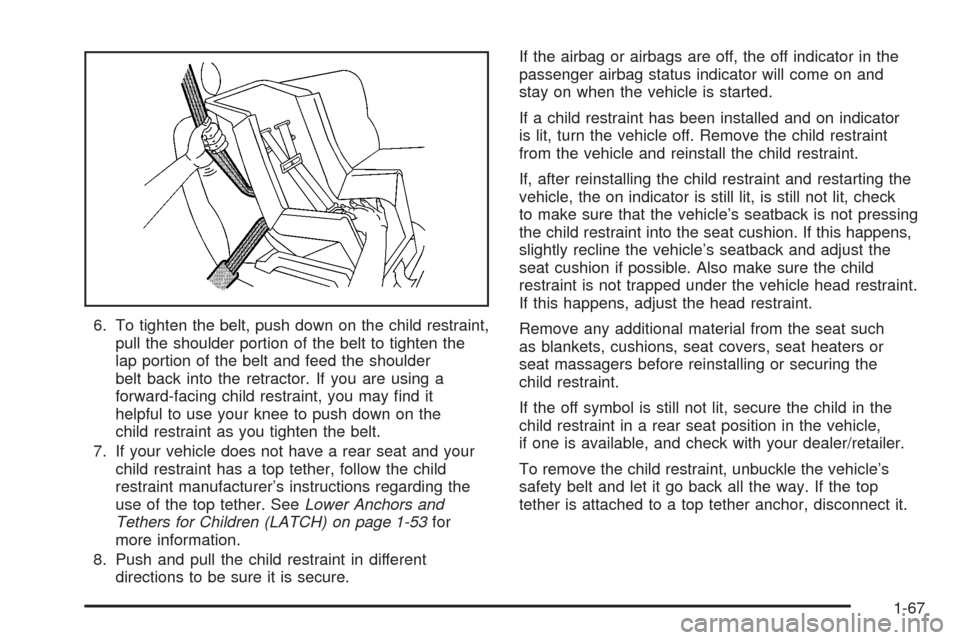
6. To tighten the belt, push down on the child restraint,
pull the shoulder portion of the belt to tighten the
lap portion of the belt and feed the shoulder
belt back into the retractor. If you are using a
forward-facing child restraint, you may �nd it
helpful to use your knee to push down on the
child restraint as you tighten the belt.
7. If your vehicle does not have a rear seat and your
child restraint has a top tether, follow the child
restraint manufacturer’s instructions regarding the
use of the top tether. SeeLower Anchors and
Tethers for Children (LATCH) on page 1-53for
more information.
8. Push and pull the child restraint in different
directions to be sure it is secure.If the airbag or airbags are off, the off indicator in the
passenger airbag status indicator will come on and
stay on when the vehicle is started.
If a child restraint has been installed and on indicator
is lit, turn the vehicle off. Remove the child restraint
from the vehicle and reinstall the child restraint.
If, after reinstalling the child restraint and restarting the
vehicle, the on indicator is still lit, is still not lit, check
to make sure that the vehicle’s seatback is not pressing
the child restraint into the seat cushion. If this happens,
slightly recline the vehicle’s seatback and adjust the
seat cushion if possible. Also make sure the child
restraint is not trapped under the vehicle head restraint.
If this happens, adjust the head restraint.
Remove any additional material from the seat such
as blankets, cushions, seat covers, seat heaters or
seat massagers before reinstalling or securing the
child restraint.
If the off symbol is still not lit, secure the child in the
child restraint in a rear seat position in the vehicle,
if one is available, and check with your dealer/retailer.
To remove the child restraint, unbuckle the vehicle’s
safety belt and let it go back all the way. If the top
tether is attached to a top tether anchor, disconnect it.
1-67
Page 72 of 476
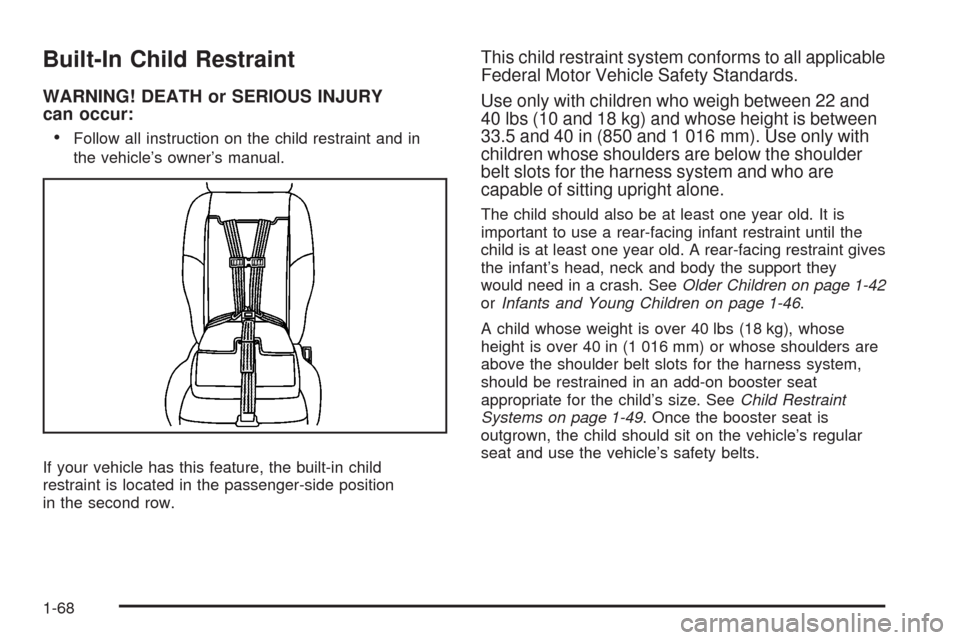
Built-In Child Restraint
WARNING! DEATH or SERIOUS INJURY
can occur:
Follow all instruction on the child restraint and in
the vehicle’s owner’s manual.
If your vehicle has this feature, the built-in child
restraint is located in the passenger-side position
in the second row.
This child restraint system conforms to all applicable
Federal Motor Vehicle Safety Standards.
Use only with children who weigh between 22 and
40 lbs (10 and 18 kg) and whose height is between
33.5 and 40 in (850 and 1 016 mm). Use only with
children whose shoulders are below the shoulder
belt slots for the harness system and who are
capable of sitting upright alone.
The child should also be at least one year old. It is
important to use a rear-facing infant restraint until the
child is at least one year old. A rear-facing restraint gives
the infant’s head, neck and body the support they
would need in a crash. SeeOlder Children on page 1-42
orInfants and Young Children on page 1-46.
A child whose weight is over 40 lbs (18 kg), whose
height is over 40 in (1 016 mm) or whose shoulders are
above the shoulder belt slots for the harness system,
should be restrained in an add-on booster seat
appropriate for the child’s size. SeeChild Restraint
Systems on page 1-49. Once the booster seat is
outgrown, the child should sit on the vehicle’s regular
seat and use the vehicle’s safety belts.
1-68
Page 73 of 476
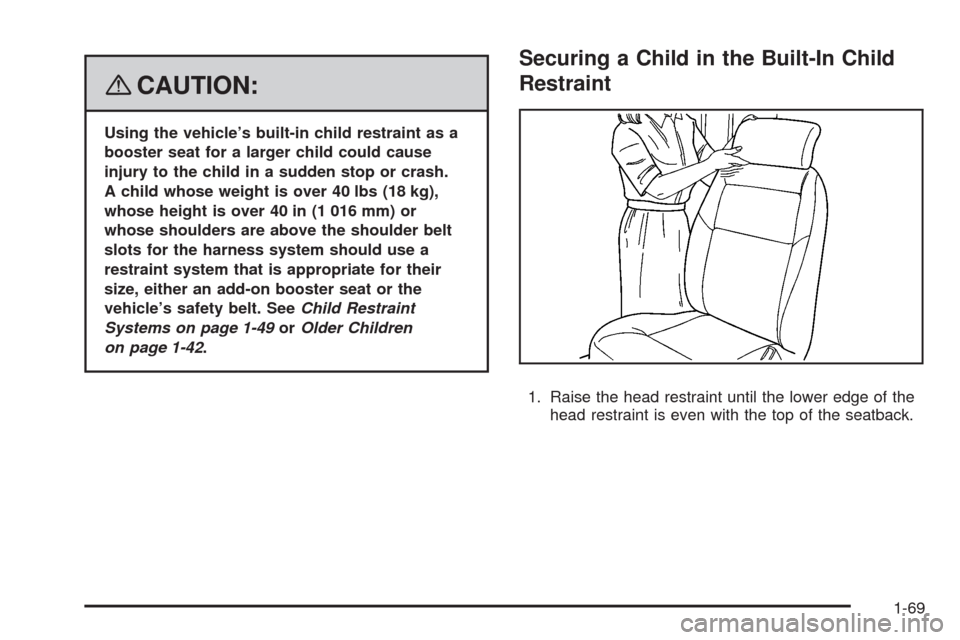
{CAUTION:
Using the vehicle’s built-in child restraint as a
booster seat for a larger child could cause
injury to the child in a sudden stop or crash.
A child whose weight is over 40 lbs (18 kg),
whose height is over 40 in (1 016 mm) or
whose shoulders are above the shoulder belt
slots for the harness system should use a
restraint system that is appropriate for their
size, either an add-on booster seat or the
vehicle’s safety belt. SeeChild Restraint
Systems on page 1-49orOlder Children
on page 1-42.
Securing a Child in the Built-In Child
Restraint
1. Raise the head restraint until the lower edge of the
head restraint is even with the top of the seatback.
1-69
Page 74 of 476
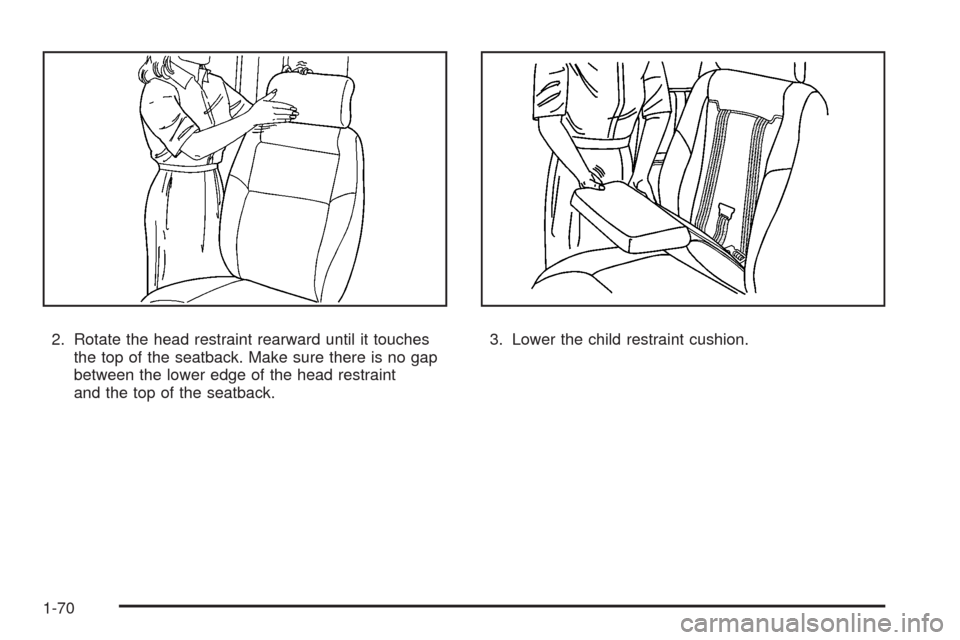
2. Rotate the head restraint rearward until it touches
the top of the seatback. Make sure there is no gap
between the lower edge of the head restraint
and the top of the seatback.3. Lower the child restraint cushion.
1-70
Page 75 of 476
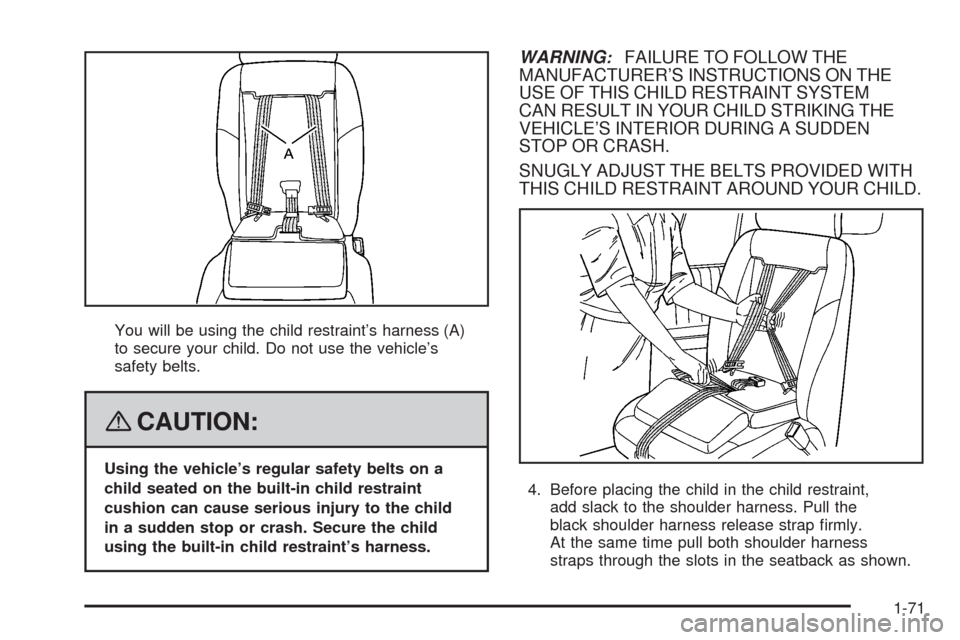
You will be using the child restraint’s harness (A)
to secure your child. Do not use the vehicle’s
safety belts.
{CAUTION:
Using the vehicle’s regular safety belts on a
child seated on the built-in child restraint
cushion can cause serious injury to the child
in a sudden stop or crash. Secure the child
using the built-in child restraint’s harness.
WARNING:FAILURE TO FOLLOW THE
MANUFACTURER’S INSTRUCTIONS ON THE
USE OF THIS CHILD RESTRAINT SYSTEM
CAN RESULT IN YOUR CHILD STRIKING THE
VEHICLE’S INTERIOR DURING A SUDDEN
STOP OR CRASH.
SNUGLY ADJUST THE BELTS PROVIDED WITH
THIS CHILD RESTRAINT AROUND YOUR CHILD.
4. Before placing the child in the child restraint,
add slack to the shoulder harness. Pull the
black shoulder harness release strap �rmly.
At the same time pull both shoulder harness
straps through the slots in the seatback as shown.
1-71
Page 76 of 476
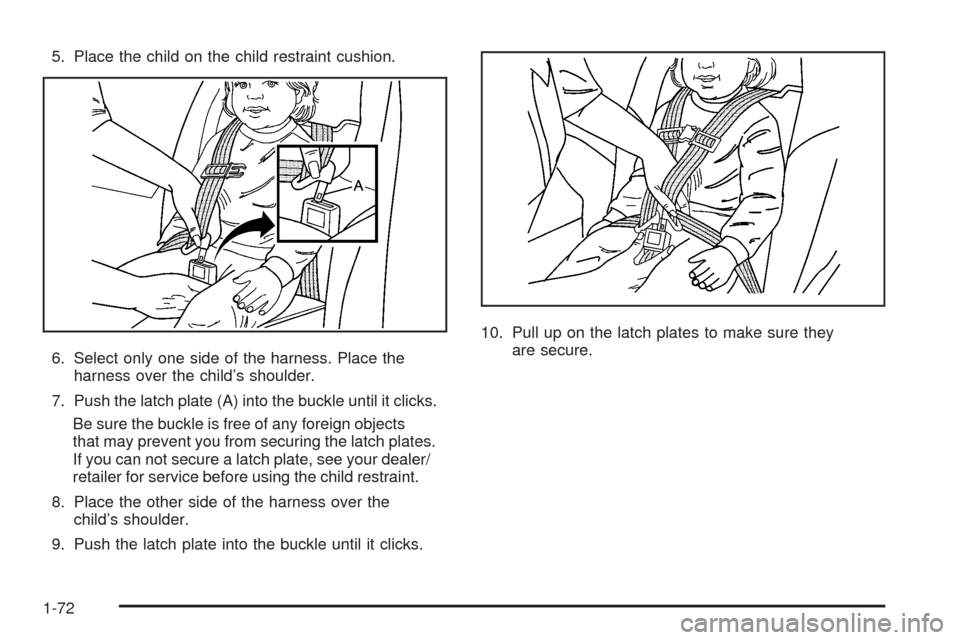
5. Place the child on the child restraint cushion.
6. Select only one side of the harness. Place the
harness over the child’s shoulder.
7. Push the latch plate (A) into the buckle until it clicks.
Be sure the buckle is free of any foreign objects
that may prevent you from securing the latch plates.
If you can not secure a latch plate, see your dealer/
retailer for service before using the child restraint.
8. Place the other side of the harness over the
child’s shoulder.
9. Push the latch plate into the buckle until it clicks.10. Pull up on the latch plates to make sure they
are secure.
1-72
Page 77 of 476

11. Now fasten the left and right halves of the shoulder
harness clip together. The clip can be easily pulled
apart and is designed to pull apart during a collision.
{CAUTION:
A built-in child restraint harness that is not
properly adjusted can cause injury to the child
in a sudden stop or collision. A harness that is
loose, twisted, worn improperly or improperly
CAUTION: (Continued)
CAUTION: (Continued)
fastened will not be able to restrain the child’s
upper body. Make sure the harness is adjusted
correctly. Fastening the clip is not a substitute
for adjusting the harness so that it is snug.
12. Pull the shoulder harness adjustment strap (A) �rmly
until the harness is snugly adjusted around the child.
You should not be able to put more than two �ngers
between the harness and the child’s chest. Make
sure the harness and buckle strap are not twisted.
1-73
Page 78 of 476
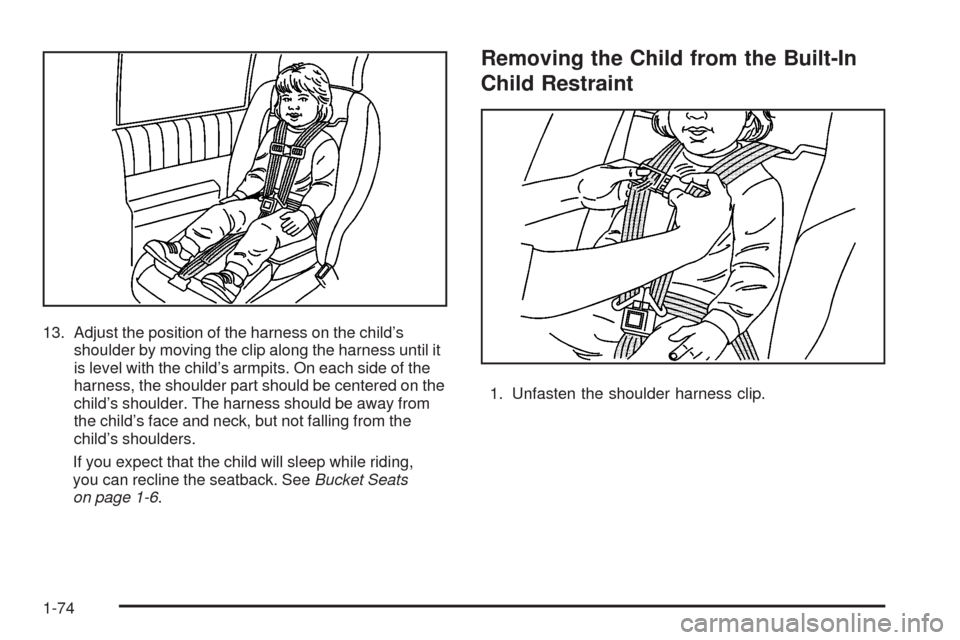
13. Adjust the position of the harness on the child’s
shoulder by moving the clip along the harness until it
is level with the child’s armpits. On each side of the
harness, the shoulder part should be centered on the
child’s shoulder. The harness should be away from
the child’s face and neck, but not falling from the
child’s shoulders.
If you expect that the child will sleep while riding,
you can recline the seatback. SeeBucket Seats
on page 1-6.
Removing the Child from the Built-In
Child Restraint
1. Unfasten the shoulder harness clip.
1-74
Page 79 of 476
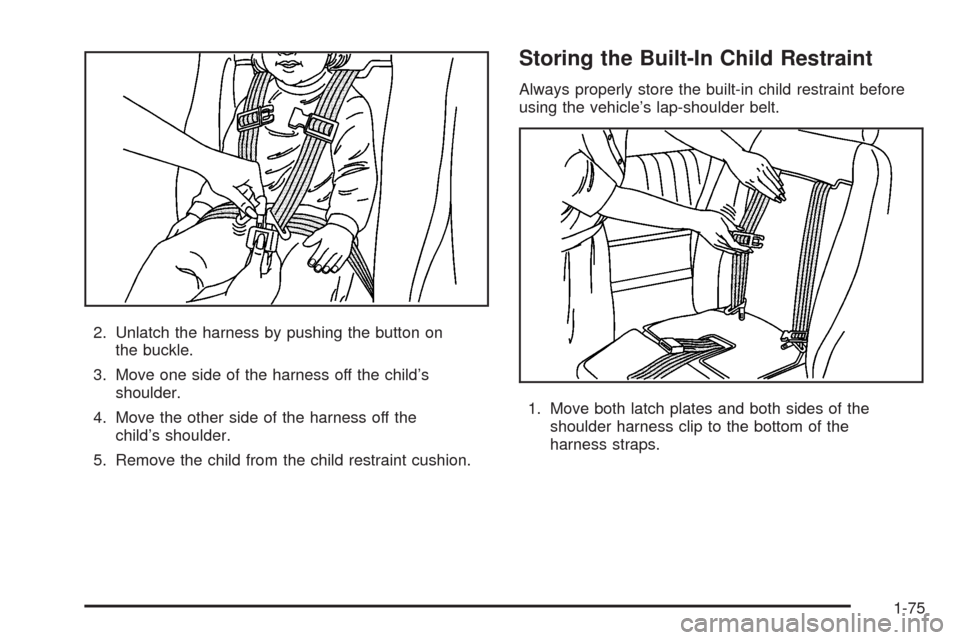
2. Unlatch the harness by pushing the button on
the buckle.
3. Move one side of the harness off the child’s
shoulder.
4. Move the other side of the harness off the
child’s shoulder.
5. Remove the child from the child restraint cushion.
Storing the Built-In Child Restraint
Always properly store the built-in child restraint before
using the vehicle’s lap-shoulder belt.
1. Move both latch plates and both sides of the
shoulder harness clip to the bottom of the
harness straps.
1-75
Page 80 of 476
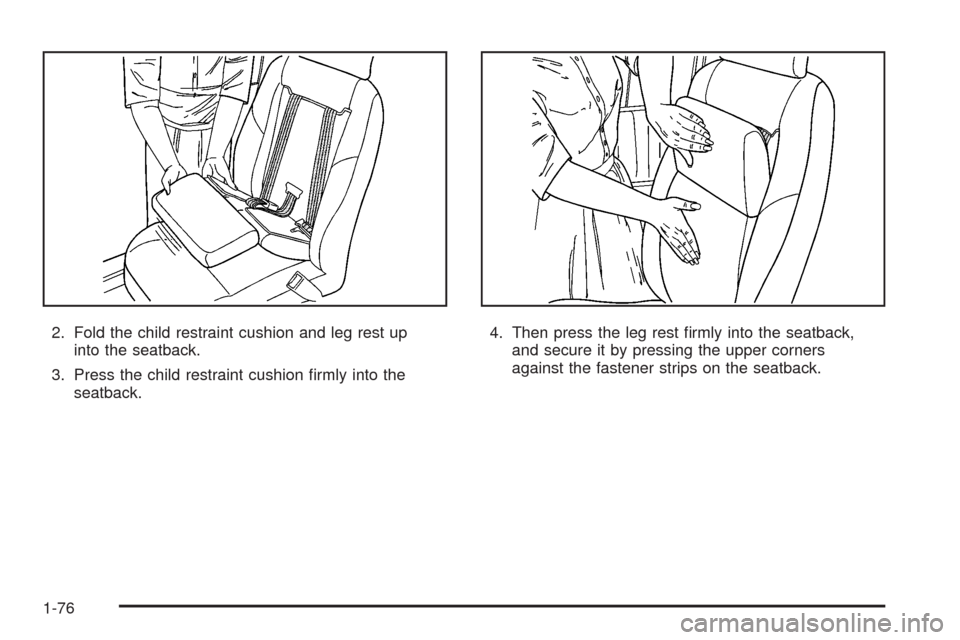
2. Fold the child restraint cushion and leg rest up
into the seatback.
3. Press the child restraint cushion �rmly into the
seatback.4. Then press the leg rest �rmly into the seatback,
and secure it by pressing the upper corners
against the fastener strips on the seatback.
1-76